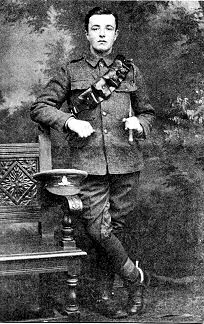This is my transcription of
my Grandfather’s memoirs
On 26th July 1914 Edmund Lenfestey (Le Bordage,
St Peter's) joined No.1 Company of the Royal Guernsey
Artillery as an eighteen year old. Eight days
later England declared war on Germany. On 20th
November 1915 Edmund with his friends, John Corbin
(Le Douit, St Peter's) and Clarence
Tostevin (La Couture, St Peter's) volunteered
for active service and joined the Royal Field
Artillery.
In January 1916 about forty Guernsey volunteers
left for Swanage where Edmund and his friends
spent two and a half months training to man 4.5
inch howitzer batteries. They were then sent to
Woolwich, the headquarters of the Artillery, before
being ordered to France. Crossing from Southampton
to Le Havre, they disembarked and marched for
two hours to Harfleur on a cold and wet day in
March 1916.
|

Edmund Lenfestey, Royal Field Artillery
taken at Swanage
|
|
"During the eight days in Harfleur we occupied
our time in gun-drill and fatigues down at the docks,
feeding only on bully and biscuits. We were now
only twenty Guernseymen amongst thousands belonging
to different regiments. .....the three of us were
split up, one in each division. John was sent to
the 2nd Division and myself to the 7th Division.
Clarence stopped behind with a rash. Wished John
au revoir at Rouen, not to see him again for 18
months."
The Battle of the Somme (July 1916)
The 7th Division* captured Mametz, a success
on 1st July 1916 in contrast to the disasters North
of and along the Albert-Bapaume road. There were
further successes for the Division during the night
attack of 14 July.
"Some of us disentrained at Morlancourt on
the river Somme and I was posted to the 35th Howitzer
Battery, 22nd Brigade. I was now a lone Guernseyman
and had to make myself at home in the battery, being
the only Kitchener's man amongst regulars. My battery
was in action at Bray-sur-Corbie firing on Mametz.
The horses and wagons were stationed at Sailly-le-Sec.
After being rather quiet, only firing a few shells
a day, we got ready for the big advance. The British
started the offensive on a wide front on 1st July
at 5.26am. We bombarded for two hours with ceaseless
firing covering our infantry as they went "over
the top" The infantry captured all objectives
though suffering heavy casualties (the 7th Division
had 3410 casualities on the first day). Thousands
of German prisoners passed quite close to our guns
two miles behind the front line. After this advance
we stood by all night and day for fear of a counter-attack
which eventually came. At that time we had only
one casualty, a lad killed outright. Our six guns
advanced to Mametz Wood (10th July), passing through
villages completely destroyed by our shells, including
Fricourt. Another four weeks firing night and day,
for we were pressing the Germans back, and then
the 7th Division retired from action for a fortnight's
rest at Heilly near Corbie. This was the first fortnight
of August 1916 and there I had news of my father's
death."
Page 2  |
|